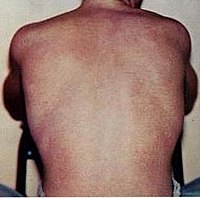
Photo from wikipedia
Severe Fever with Thrombocytopenia Syndrome Virus (SFTSV) was recently identified as a tick-borne pathogen that threat to human health. Since 2010, many countries including China, South Korea, and Japan have… Click to show full abstract
Severe Fever with Thrombocytopenia Syndrome Virus (SFTSV) was recently identified as a tick-borne pathogen that threat to human health. Since 2010, many countries including China, South Korea, and Japan have reported Human SFTS caused by SFTSV infection. The glycoprotein encoded by the SFTSV M gene is the major antigenic component on the viral surface, and responsible for the viral entry, which makes it an important viral antigen and a clinical diagnostic target. The present study aimed to map linear B cell epitopes (BCEs) on the N-terminal glycoprotein (Gn) from SFTSV strain WCH/97/HN/China/2011 using the modified biosynthetic peptide method. Five fine epitopes (E1, 196FSQSEFPD203; E2, 232GHSHKII238; E3, 256VCYKEGTGPC265; E4, 285FCKVAG290, and E5, 316SYGGM320) were identified using the rabbit antisera. Western blot analysis showed that all the five epitopes interacted with the positive serum of sheep that had been naturally infected with SFTSV. Three-dimensional structural modeling analysis showed that all identified BCEs were located on the surface of the SFTSV-Gn and contained flexible loops. The sequence alignment revealed high conservation of the identified BCEs among 13 SFTSV strains from different lineage. These mapped epitopes will escalate the understanding of the epitope distribution and pathogenic mechanism of SFTSV, and could provide a basis for the development of a SFTSV multi-epitope detection antigen.
Journal Title: PLoS ONE
Year Published: 2021
Link to full text (if available)
Share on Social Media: Sign Up to like & get
recommendations!